Performance Assessment of Algorithms for Building Energy Optimization Problems with Different Properties
Abstract
1. Introduction
1.1. Background
1.2. Literature Review
- Exclusively focus on the algorithms’ performance in solving BEO problems. Based on our recently published review [2], only a few researchers have paid close attention to such topics [4,17,18]. However, in this sector, research studies that focus on the properties of BEO problems are seriously scarce.
- Use of existing or improved algorithms to solve specific BEO problems without exploring their effectiveness and efficiency. Such studies are the major portion of this body of literature, and many algorithms have been used in optimization of the energy generation, building envelope and systems [6]. Such studies can be found in [19,20,21,22].
- Experimental design for the control parameter settings in algorithms. The performance of algorithms is dependent on the settings of their control parameters. Development of a helpful method for setting the appropriate algorithm parameters is one of the most demanding and important areas of research in BEO especially for expensive computational optimization problems. Few works have examined this topic [23,24,25]. In this study, we do not focus on this topic.
1.3. Research Outline
- Classification of the properties of BEO problems.
- Proposal of two approaches to analyze the properties of BEO problems.
- Development of six BEO test problems with different properties for the performance evaluation of algorithms.
- Assessment of the performance of the four chosen algorithms in solving the test problems using the indices proposed in our previous work [4].
2. Methodology
2.1. Classification of the Properties of BEO Problems
2.1.1. Design Variables
2.1.2. Objective Functions
2.1.3. Existence of Constraints
2.2. Approaches Used to Determine the Properties of BEO Problems
2.2.1. Standard Building Model
2.2.2. Analytical Approach
2.2.3. Numerical Approach
2.2.4. Results Comparison
2.3. Six Test BEO Problems with Different Properties
2.3.1. Test 1: Wall Conductivity
2.3.2. Test 2: Orientation
2.3.3. Test 3: Floor Height
2.3.4. Test 4: Aspect Ratio
2.3.5. Test 5: Wall Conductivity and Orientation
2.3.6. Test 6: Wall Conductivity and Cooling Setpoint for the Zone Air Temperature
2.4. Description of the Optimization Algorithms Being Evaluated
2.4.1. Discrete Armijo Gradient Algorithm
2.4.2. Hooke-Jeeves Algorithm
2.4.3. PSO Algorithm
2.4.4. Hybrid PSO and Hooke-Jeeves Algorithm
2.5. Performance Evaluation Criteria
3. Results and Analysis
3.1. Stability
3.2. Validity
3.3. Speed
3.4. Coverage
4. Conclusions
- Strictly convex and non-convex. As shown in Table 6 and Table 7, the performance behavior of each algorithm in solving Test 1 is quite similar to that of Test 4. This result means strictly convex or non-convex properties in BEO problems do not drive different performance behaviors for the four selected algorithms. Additionally, the strictly convex property appears to require the discrete Armijo gradient and the PSO to use additional time to converge to the global optimum.
- Linear and non-linear. For each selected algorithm, linear or non-linear properties in uni-modal BEO problems appear to have no influence on their performance behaviors, according to the evaluation results for Test 3 with Test 1 and 4. Specifically, the speed of the Hooke-Jeeves is excellent in solving linear problems.
- Multimodal. In tackling Test 2, the Hooke-Jeeves and the discrete Armijo gradient performed poorly in terms of validity and coverage. Both algorithms were confirmed to be trapped by local optima. Thus, multi-modality tends to cause difficulty for these two algorithms. In contrast, the specific property does not pose problems for the PSO algorithm and the hybrid algorithm, considering their good performance in Test 2.
- Multi-dimensional. Based on the poor performance behavior in Test 5, the Hooke-Jeeves and the discrete Armijo gradient appear to have suffered from the “curse of dimensionality”, which indicates that as the dimensions of the search space increases, their performance deteriorates rapidly. The reason for this is that the solution space of a problem typically grows exponentially with the problem dimension. As a result, algorithms may fail to explore all possible space within limited time.
- Discrete. According to the optimization results of Test 6, the Hooke-Jeeves and the discrete Armijo gradient are not applicable for BEO problems with discrete variables. In contrast, the hybrid PSO and Hooke-Jeeves algorithm is the best choice among the four algorithms for mixed-integer problems.
- All of properties in the six test problems do not affect the stability of all selected algorithms, considering their notably good performance in the stability evaluation for each test problem.
5. Future Works
Author Contributions
Funding
Conflicts of Interest
Appendix A
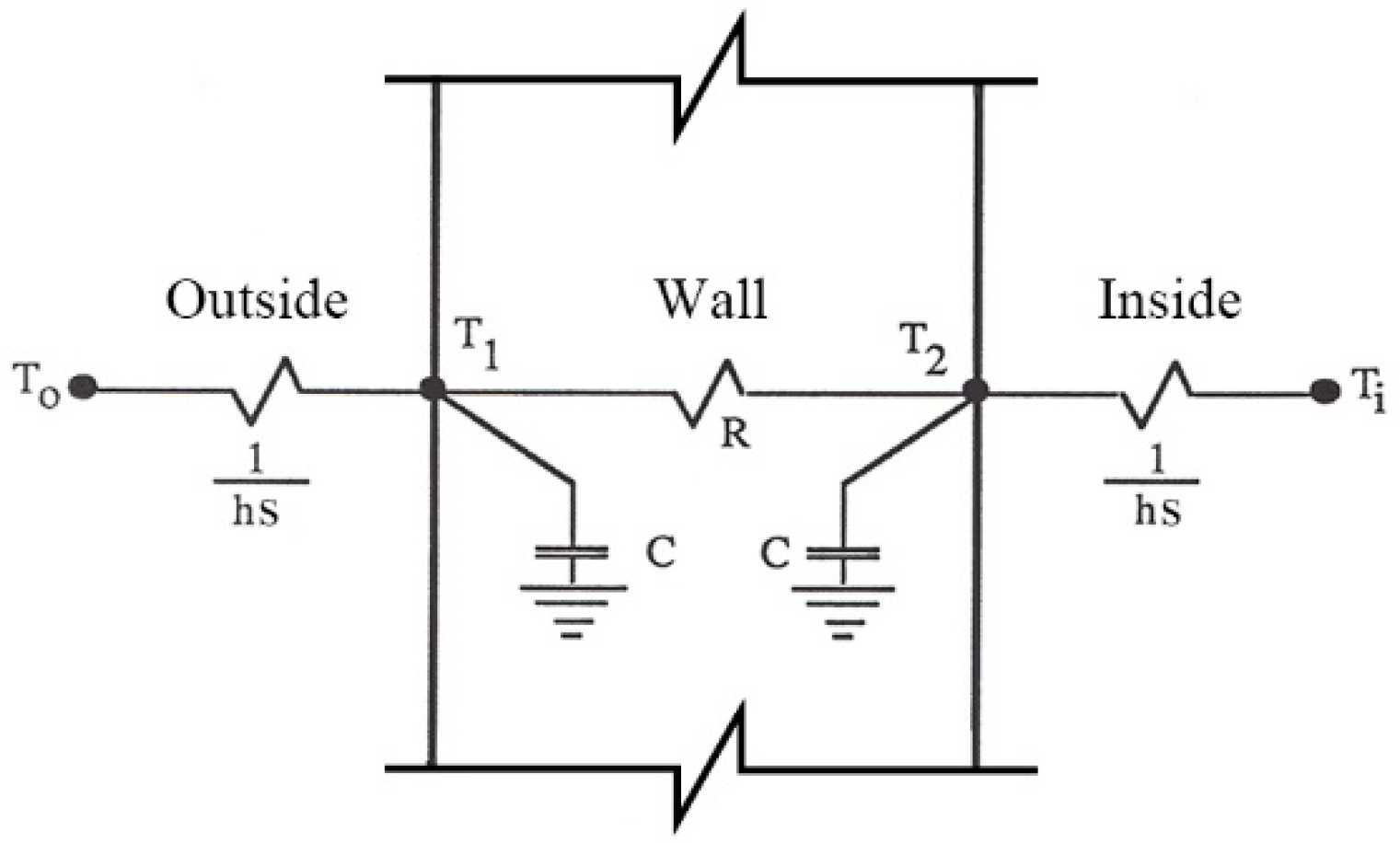
References
- Abergel, T.; Dean, B.; Dulac, J. Towards a Zero-Emission, Efficient, and Resilient Buildings and Construction Sector: Global Status Report 2017; UN Environment and International Energy Agency: Paris, France, 2017. [Google Scholar]
- Shi, X.; Tian, Z.; Chen, W.; Si, B.; Jin, X. A review on building energy efficient design optimization from the perspective of architects. Renew. Sustain. Energy Rev. 2016, 65, 872–884. [Google Scholar] [CrossRef]
- Hensen, J.L.M.; Lamberts, R. Building Performance Simulation for Design and Operation; Spon Press: Abingdon, UK, 2011. [Google Scholar]
- Si, B.; Tian, Z.; Jin, X.; Zhou, X.; Tang, P.; Shi, X. Performance indices and evaluation of algorithms in building energy efficient design optimization. Energy 2016, 114, 100–112. [Google Scholar] [CrossRef]
- Terzidis, K. Algorithmic Architecture; Elsevier and Architectural Press: Oxford, UK, 2006. [Google Scholar]
- Evins, R. A review of computational optimisation methods applied to sustainable building design. Renew. Sustain. Energy Rev. 2013, 22, 230–245. [Google Scholar] [CrossRef]
- Nguyen, A.T.; Reiter, S.; Rigo, P. A review on simulation-based optimization methods applied to building performance analysis. Appl. Energy 2014, 113, 1043–1058. [Google Scholar] [CrossRef]
- Machairas, V.; Tsangrassoulis, A.; Axarli, K. Algorithms for optimization of building design: A review. Renew. Sustain. Energy Rev. 2014, 31, 101–112. [Google Scholar] [CrossRef]
- Goldberg, D.E. Genetic Algorithms in Search, Optimization, and Machine Learning; Addison-Wesley Pub. Co.: London, UK, 1989. [Google Scholar]
- Deb, K.; Pratap, A.; Agarwal, S.; Meyarivan, T. A fast and elitist multiobjective genetic algorithm: NSGA-II. IEEE Trans. Evolut. Comput. 2002, 6, 182–197. [Google Scholar] [CrossRef]
- Rios, L.M.; Sahinidis, N.V. Derivative-free optimization: A review of algorithms and comparison of software implementations. J. Glob. Optim. 2013, 56, 1247–1293. [Google Scholar] [CrossRef]
- Mahi, M.; Ömer, K.B.; Kodaz, H. A new hybrid method based on Particle Swarm Optimization, Ant Colony Optimization and 3-Opt algorithms for Traveling Salesman Problem. Appl. Soft Comput. 2015, 30, 484–490. [Google Scholar] [CrossRef]
- Liang, J.J.; Runarsson, T.P.; Mezura-Montes, E.; Clerc, M.; Suganthan, P.N.; Carlos, C.C.; Deb, K. Problem definitions and evaluation criteria for the CEC 2006 special session on constrained real-parameter optimization. J. App. Mech. 2006, 41, 8–31. [Google Scholar]
- Liang, J.J.; Qu, B.Y.; Suganthan, P.N.; Hernández-Díaz, A.G. Problem Definitions and Evaluation Criteria for the CEC 2013 Special Session on Real-Parameter Optimization; Nanyang Technological University: Singapore, 2013. [Google Scholar]
- Das, S.; Suganthan, P.N. Problem Definitions and Evaluation World Optimization Problems. Technical Report. December 2010. Available online: http://web.mysites.ntu.edu.sg/epnsugan/PublicSite/Shared%20Documents/CEC%202011-%20RWP/Tech-Rep.pdf (accessed on 8 August 2018).
- Rao, S.S. Engineering Optimization: Theory and Practice, 4th ed.; John Wiley & Sons, Inc.: Hoboken, NJ, USA, 1996. [Google Scholar]
- Hamdy, M.; Nguyen, A.T.; Hensen, J.L. A performance comparison of multi-objective optimization algorithms for solving nearly-zero-energy-building design problems. Energy Build. 2016, 121, 57–71. [Google Scholar] [CrossRef]
- Wetter, M.; Wright, J. A comparison of deterministic and probabilistic optimization algorithms for nonsmooth simulation-based optimization. Build. Environ. 2004, 39, 989–999. [Google Scholar] [CrossRef]
- Feng, K.; Lu, W.; Chen, S.; Wang, Y. An Integrated Environment-Cost-Time Optimisation Method for Construction Contractors Considering Global Warming. Sustainability 2018, 10, 4207. [Google Scholar] [CrossRef]
- Zheng, B.; Bedra, K.B.; Zheng, J.; Wang, G. Combination of Tree Configuration with Street Configuration for Thermal Comfort Optimization under Extreme Summer Conditions in the Urban Center of Shantou City, China. Sustainability 2018, 10, 4192. [Google Scholar] [CrossRef]
- Lin, Y.; Zhou, S.; Yang, W.; Li, C. Design Optimization Considering Variable Thermal Mass, Insulation, Absorptance of Solar Radiation, and Glazing Ratio Using a Prediction Model and Genetic Algorithm. Sustainability 2018, 10, 336. [Google Scholar] [CrossRef]
- Han, Y.; Yu, H.; Sun, C. Simulation-Based Multiobjective Optimization of Timber-Glass Residential Buildings in Severe Cold Regions. Sustainability 2017, 9, 2353. [Google Scholar] [CrossRef]
- Mihail–Bogdan, C.Ă.; Constantin, I.O.; Horia, N.E. The influence of Genetic Algorithm parameters over the efficiency of the energy consumption estimation in a low–energy building. Energy Procedia 2016, 85, 99–108. [Google Scholar] [CrossRef]
- Alajmi, A.; Wright, J. Selecting the most efficient genetic algorithm sets in solving unconstrained building optimization problem. Int. J. Sustain. Built Environ. 2014, 3, 18–26. [Google Scholar] [CrossRef]
- Wright, J.; Alajmi, A. Efficient Genetic Algorithm sets for optimizing constrained building design problem. Int. J. Sustain. Built Environ. 2016, 5, 123–131. [Google Scholar] [CrossRef]
- Hopfe, C.J.; Emmerich, M.T.; Marijt, R.; Hensen, J. Robust multi-criteria design optimisation in building design. In Proceedings of the 2012 Building Simulation and Optimization Conference, Leicestershire, Loughborough, 10–11 September 2012; pp. 19–26. [Google Scholar]
- Sager, S.; Bock, H.G.; Reinelt, G. Direct methods with maximal lower bound for mixed-integer optimal control problems. Math. Programm. 2009, 118, 109–149. [Google Scholar] [CrossRef]
- Khan, M.A.I.; Noakes, C.J.; Toropov, V.V. Multi-objective optimization of the ventilation system design in a two-bed ward with an emphasis on infection control. In Proceedings of the 2012 Building Simulation and Optimization Conference, Leicestershire, Loughborough, 10–11 September 2012; pp. 9–18. [Google Scholar]
- Wetter, M.; Polak, E. A convergent optimization method using pattern search algorithms with adaptive precision simulation. Build. Service Eng. 2004, 25, 327–338. [Google Scholar] [CrossRef]
- Nguyen, A.T. Sustainable Housing in Vietnam: Climate Responsive Design Strategies to Optimize Thermal Comfort. Ph.D. Thesis, Université de Liège, Wallonia, Belgium, 2013. [Google Scholar]
- Seem, J.E. Modeling of Heat Transfer in Buildings; University of Wisconsin: Madison, WI, USA, 1987. [Google Scholar]
- U.S. Department of Energy. EnergyPlus™ Version 9.0.1 Documentation Input Output Reference; U.S. Department of Energy: Washington, DC, USA, 2018.
- Ministry of Housing and Urban-Rural Development of the People’s Republic of China, General Administration of Quality Supervision Inspection and Quarantine of the People’s Republic of China. Design Standard for Energy Efficiency of Public Buildings; GB50189-2015; Ministry of Housing and Urban-Rural Development of the People’s Republic of China: Beijing, China, 2015.
- Crawley, D.B.; Lawrie, L.K.; Pedersen, C.O.; Winkelmann, F.C. Energy plus: Energy simulation program. ASHRAE J. 2000, 42, 49–56. [Google Scholar]
- Wetter, M. GenOpt® Generic Optimization Program User Manual Version3.1.0. Lawrence Berkeley National Laboratory 2011. Available online: http://simulationresearch.lbl.gov/GO/download/manual-3-1-0.pdf (accessed on 8 August 2018).
- Shen, H.; Tzempelikos, A. Daylighting and energy analysis of private offices with automated interior roller shades. Sol. Energy 2012, 86, 681–704. [Google Scholar] [CrossRef]
- Hooke, R.; Jeeves, T.A. “Direct Search” Solution of Numerical and Statistical Problems. J. ACM 1961, 8, 212–229. [Google Scholar] [CrossRef]
- Kennedy, J.; Eberhart, R. Particle swarm optimization. In Proceedings of the IEEE International Conference on Neural Networks, Perth, Australia, 27 November–1 December 1995; pp. 1942–1948. [Google Scholar]
- Kennedy, J.; Mendes, R. Population structure and particle swarm performance. In Proceedings of the 2002 Congress, Honolulu, HI, USA, 12–17 May 2002; pp. 1671–1676. [Google Scholar]
- Futrell, B.J.; Ozelkan, E.C.; Brentrup, D. Optimizing complex building design for annual daylighting performance and evaluation of optimization algorithms. Energy Build. 2015, 92, 234–245. [Google Scholar] [CrossRef]
- Ceylan, H.T.; Meyers, G.E.; Ceylan, H.T.; Meyers, G.E. Long-time solutions to heat-conduction transients with time-dependent inputs. J. Heat Transf. 1980, 102, 115–120. [Google Scholar] [CrossRef]
- Ouyang, K.; Haghighat, F. A procedure for calculating thermal response factors of multi-layer walls—State space method. Build. Environ. 1991, 26, 173–177. [Google Scholar] [CrossRef]
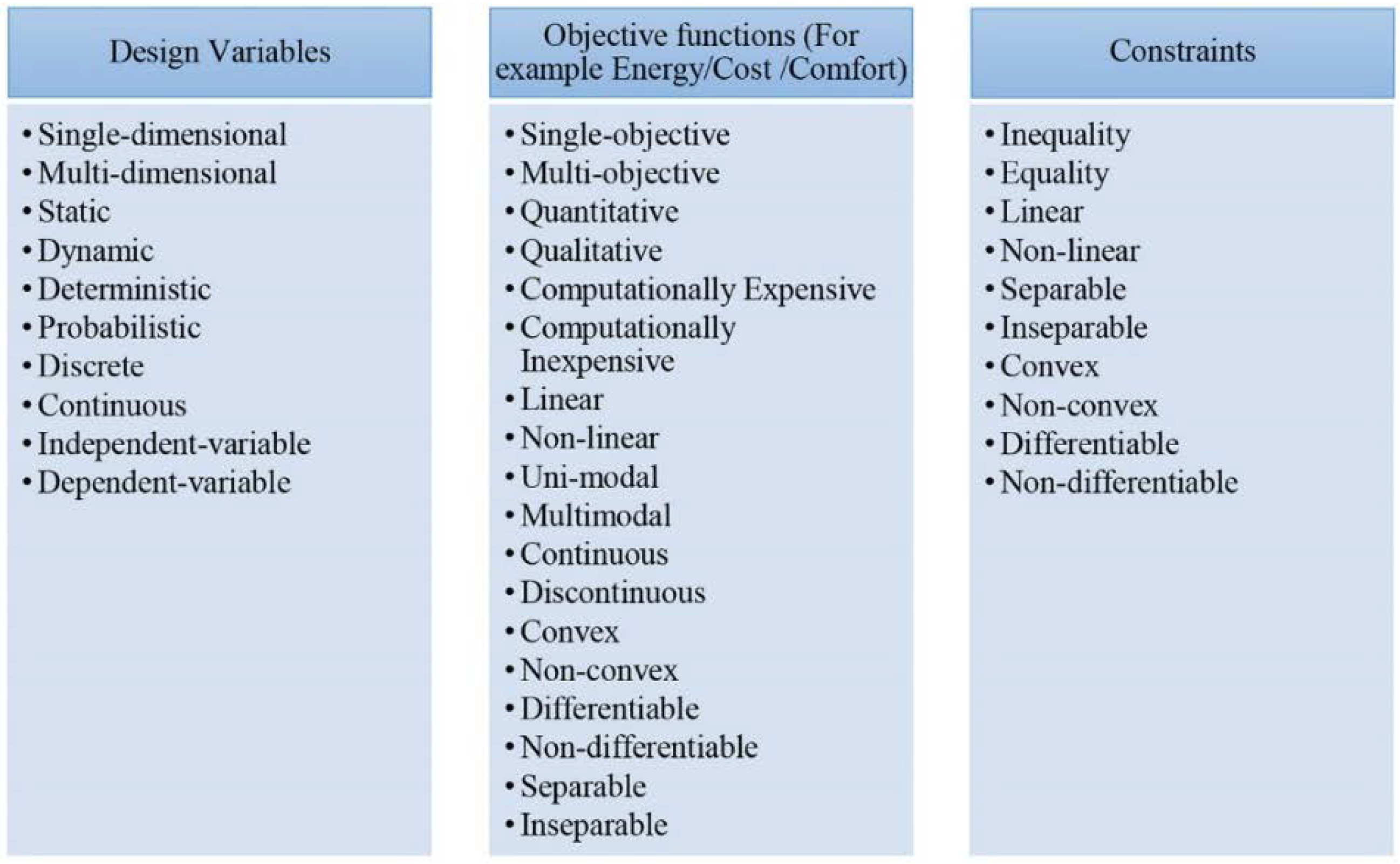
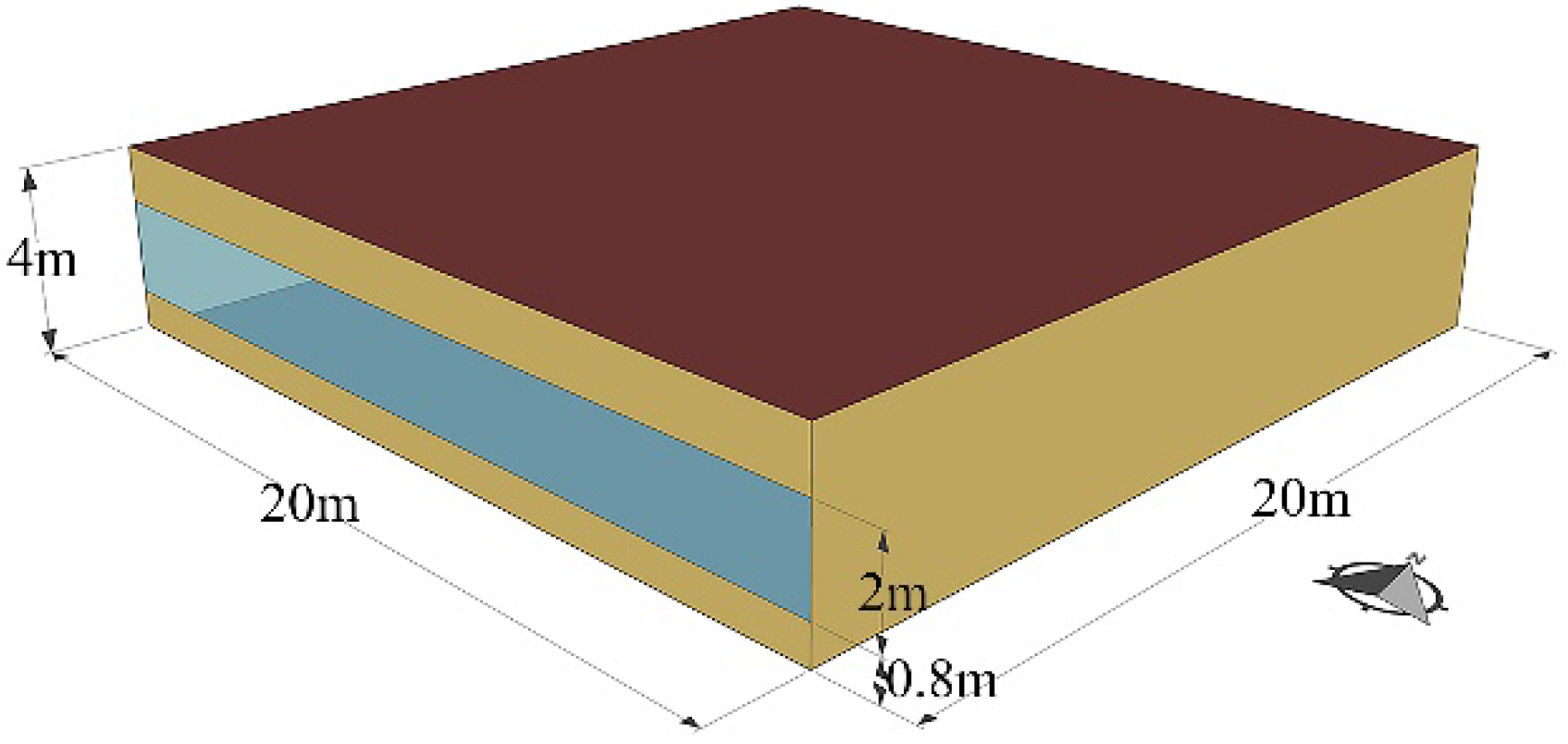



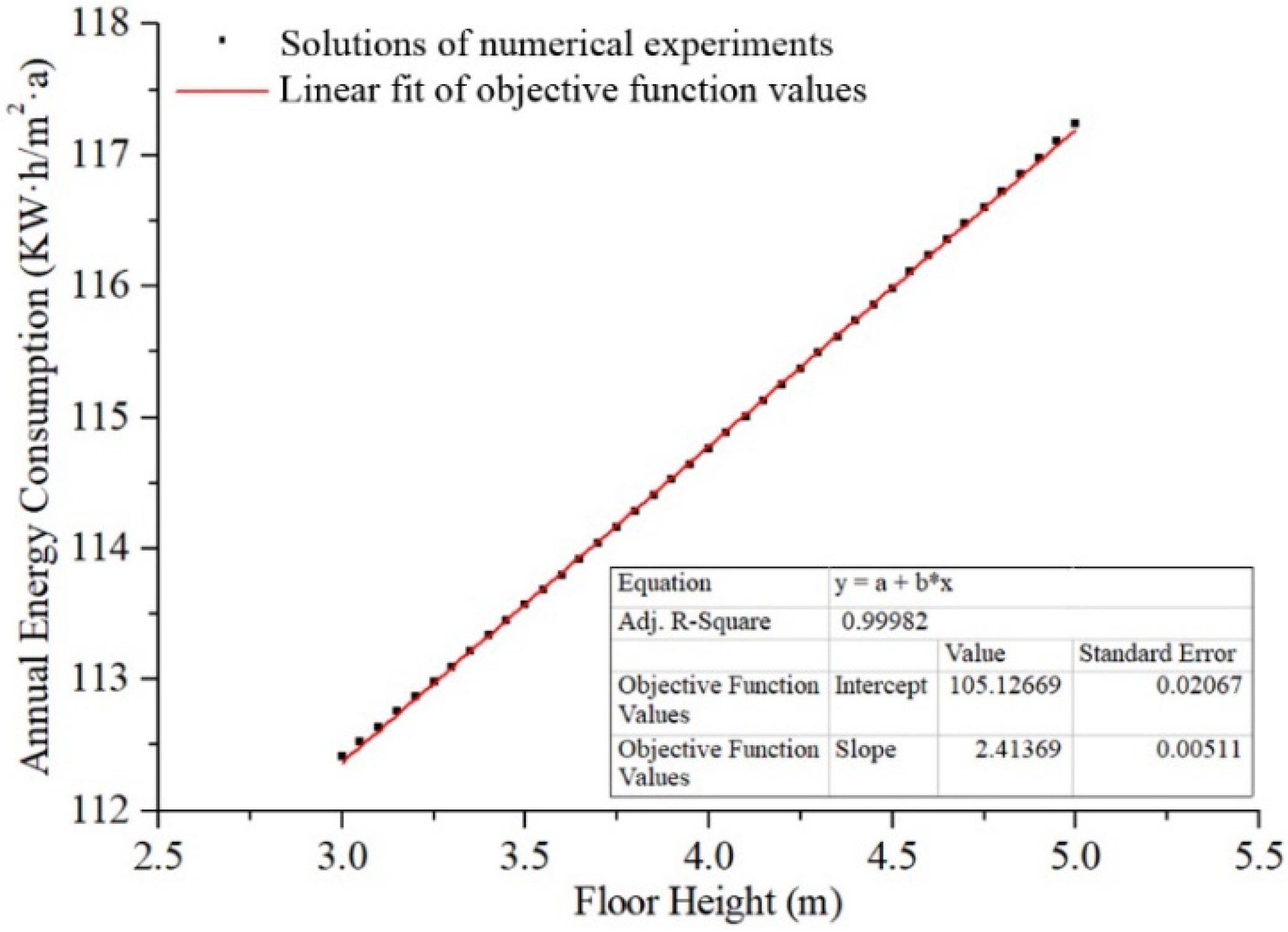

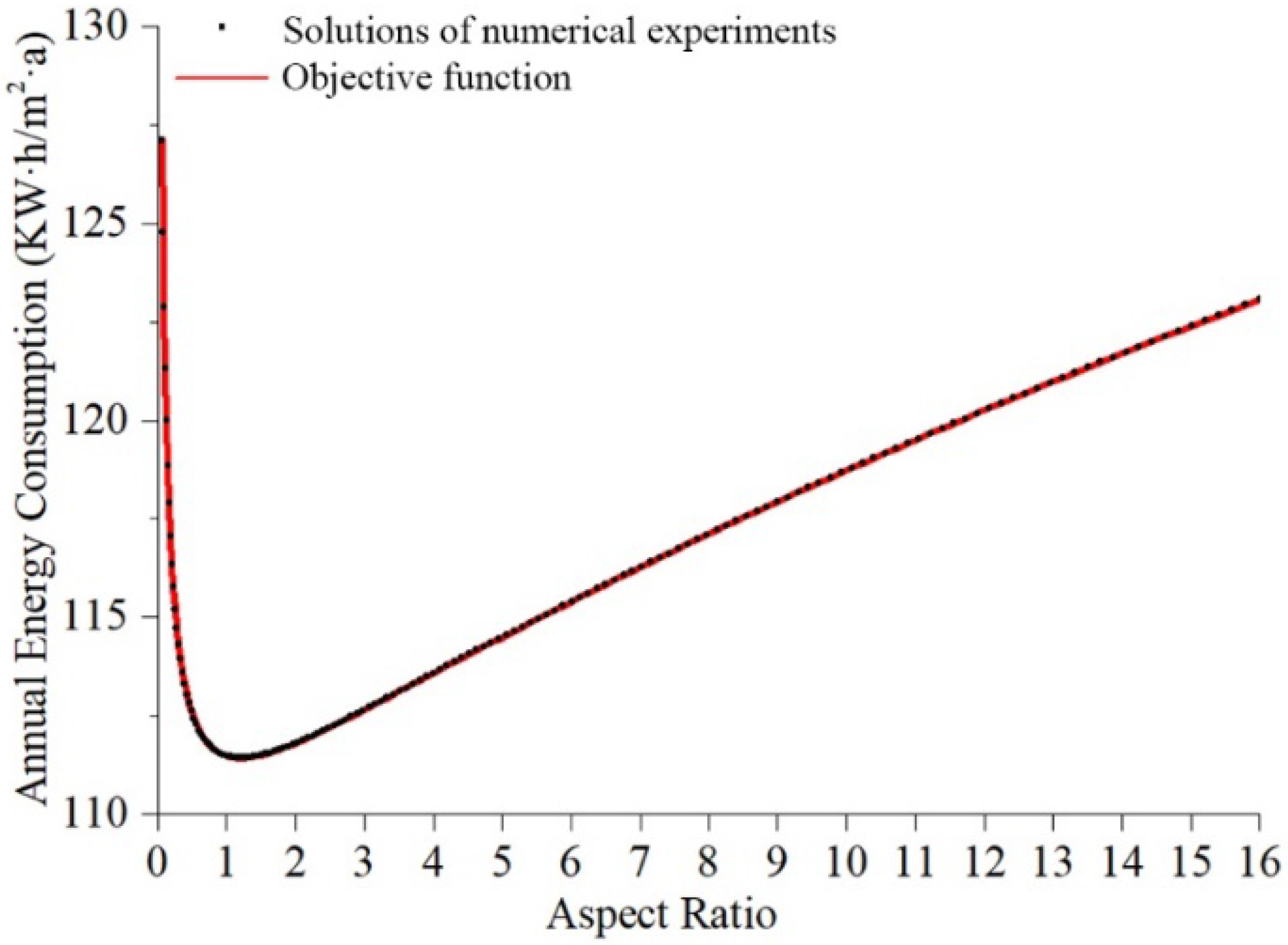
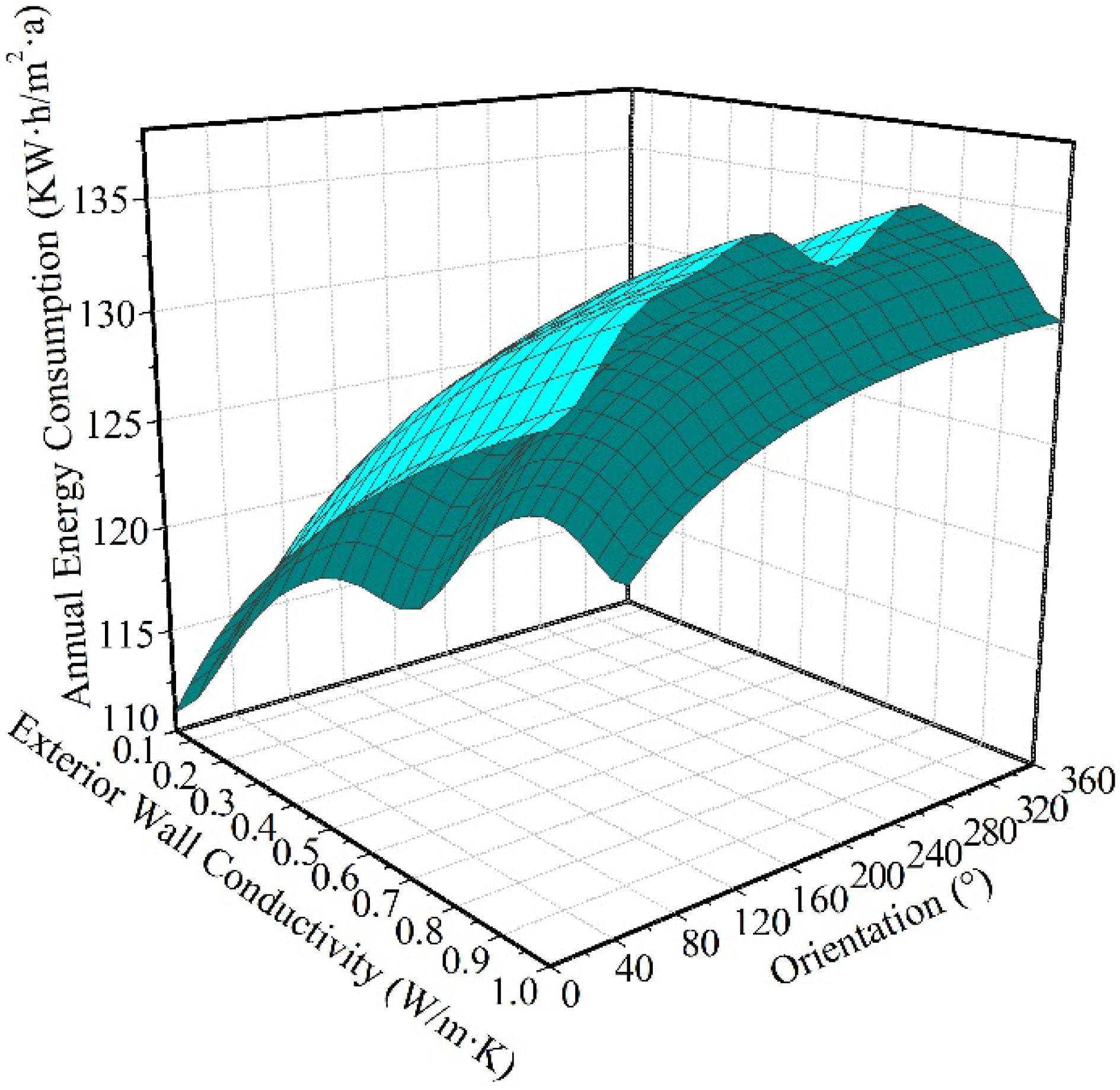


| Test Problems | Design Variables | Symbol | Unit | Step Size | Range | Initial Solution | True Optimum | ||
|---|---|---|---|---|---|---|---|---|---|
| x1 | f(X1) | x* | f(X*) | ||||||
| Test 1 | Wall Conductivity | x1 | W/m·K | 0.008 | 0.02–0.3 | 0.225 | 116.700 | 0.02 | 109.741 |
| Test 2 | Orientation | x2 | ° | 8 | 0–360 | 120 | 120.082 | 1 | 114.760 |
| Test 3 | Floor height | x3 | m | 0.2 | 3–5 | 4.5 | 120.082 | 3 | 112.409 |
| Test 4 | Length of south wall (Aspect ratio) | x4 | m | 4 | 5–80 | 60 | 117.931 | 22 | 111.423 |
| Test 5 | Wall Conductivity | x5 | W/mK | 0.008 | 0.02–0.3 | 0.225 | 121.277 | 0.02 | 109.834 |
| Orientation | x6 | ° | 8 | 0–360 | 148 | 1 | |||
| Test 6 | Wall Conductivity | x7 | W/m·K | 0.008 | 0.02–0.3 | 0.225 | 194.847 | 0.02 | 68.922 |
| Cooling Setpoint | x8 | °C | 1 | {20, 21, …, 39, 40} | 20 | 40 | |||
| Test Problems | Properties of Test Problems |
|---|---|
| Test 1 | Single-dimensional, Non-linear, Uni-modal, Non-convex, Continuous |
| Test 2 | Single-dimensional, Non-linear, Multimodal, Convex, Non-convex, Continuous |
| Test 3 | Single-dimensional, Linear, Continuous |
| Test 4 | Single-dimensional, Non-linear, Uni-modal, Convex, Continuous |
| Test 5 | Multi-dimensional, Non-linear, Multimodal, Convex, Non-convex, Continuous |
| Test 6 | Multi-dimensional, Non-linear, Uni-modal, Non-convex, Discrete |
| Variable | Unit | Algorithm | ||||
|---|---|---|---|---|---|---|
| Discrete Armijo Gradient | Hooke-Jeeves | PSO | Hybrid PSO and Hooke-Jeeves | |||
| Run Index | 1–6 | 1–6 | 1–6 | 1–6 | ||
| Test1 | m | - | 206 | 23 | 7 | 100 |
| x1’ | W/mK | 0.02002 | 0.02 | 0.025 | 0.02 | |
| f(x1’) | kWh/m2a | 109.838 | 109.741 | 110.008 | 109.741 | |
| Test 2 | m | - | 66 | 12 | 7 | 84 |
| x2’ | ° | 175.953 | 176 | 0 | 1 | |
| f(x2’) | kWh/m2a | 117.805 | 117.804 | 114.762 | 114.760 | |
| Test 3 | m | - | 226 | 11 | 7 | 89 |
| x3’ | m | 3 | 3 | 3.1 | 3 | |
| f(x3’) | kWh/m2a | 112.409 | 112.409 | 112.639 | 112.409 | |
| Test 4 | m | - | 123 | 18 | 51 | 86 |
| x4 | m | 22.044 | 22 | 24 | 22 | |
| f(x4’) | kWh/m2a | 111.424 | 111.423 | 111.468 | 111.423 | |
| Test 5 | m | - | - | 50 | 225 | 98 |
| x5’ | W/mK | - | 0.02 | 0.025 | 0.02 | |
| x6’ | ° | - | 176 | 356 | 360 | |
| f(x5’, x6’) | kWh/m2a | - | 111.152 | 110.07 | 109.838 | |
| Test 6 | m | - | - | - | 295 | 105 |
| x7’ | W/mK | - | - | 0.071 | 0.02 | |
| x8’ | ℃ | - | - | 40 | 40 | |
| f(x7’, x8’) | kWh/m2a | - | - | 72.941 | 68.922 | |
| Test 1 | Test 2 | Test 3 | Test 4 | Test 5 | Test 6 | |||||||
|---|---|---|---|---|---|---|---|---|---|---|---|---|
| d(X*, X’) | g(f(X*), f(X’)) | d(X*, X’) | g(f(X*), f(X’)) | d(X*, X’) | g(f(X*), f(X’)) | d(X*, X’) | g(f(X*), f(X’)) | d(X*, X’) | g(f(X*), f(X’)) | d(X*, X’) | g(f(X*), f(X’)) | |
| Discrete Armijo gradient | 0.00007 | 0.00088 | 0.48598 | 0.02653 | 0 | 0 | 0.00059 | 0.000009 | - | - | - | - |
| Hooke-Jeeves | 0 | 0 | 0.48611 | 0.02653 | 0 | 0 | 0 | 0 | 0.48611 | 0.012 | - | - |
| PSO | 0.01786 | 0.00243 | 0.00278 | 0.00002 | 0.05 | 0.00205 | 0.02667 | 0.0004 | 0.98627 | 0.00215 | 0.1821 | 5.831 |
| Hybrid PSO and Hooke-Jeeves | 0 | 0 | 0 | 0 | 0 | 0 | 0 | 0 | 0.99722 | 0.00004 | 0 | 0 |
| Algorithms | Test 1 | Test 2 | Test 3 | Test 4 | Test 5 | Test 6 | ||||
|---|---|---|---|---|---|---|---|---|---|---|
| SD1’ | SD2’ | SD3’ | SD4’ | SD5’ | SD6’ | SD5’* SD6’ | SD7’ | SD8’ | SD7’* SD8’ | |
| Discrete Armijo gradient | 0.328 | 0.079 | 0.331 | 0.209 | - | - | - | - | - | |
| Hooke-Jeeves | 0.107 | 0.016 | 0.085 | 0.062 | 0.133 | 0.01 | 0.001 | - | - | - |
| PSO | 0.184 | 0.311 | 0.175 | 0.127 | 0.234 | 0.25 | 0.058 | 0.205 | 0.256 | 0.052 |
| Hybrid PSO and Hooke-Jeeves | 0.193 | 0.283 | 0.193 | 0.133 | 0.219 | 0.238 | 0.052 | 0.322 | 0.341 | 0.11 |
| Discrete Armijo Gradient | Hooke-Jeeves | |||||||
|---|---|---|---|---|---|---|---|---|
| Stability | Validity | Speed | Coverage | Stability | Validity | Speed | Coverage | |
| Test 1 | G | G | P | G | G | G | G | P |
| Test 2 | G | P | F | P | G | P | G | P |
| Test 3 | G | G | P | G | G | G | G | P |
| Test 4 | G | G | P | G | G | G | G | P |
| Test 5 | - | - | - | - | G | P | G | P |
| Test 6 | - | - | - | - | - | - | - | - |
| PSO | Hybrid PSO and Hooke-Jeeves | |||||||
|---|---|---|---|---|---|---|---|---|
| Stability | Validity | Speed | Coverage | Stability | Validity | Speed | Coverage | |
| Test 1 | G | F | G | G | G | G | F | G |
| Test 2 | G | F | G | G | G | G | F | G |
| Test 3 | G | F | G | G | G | G | F | G |
| Test 4 | G | F | G | G | G | G | F | G |
| Test 5 | G | F | P | F | G | F | F | F |
| Test 6 | G | F | P | P | G | G | F | G |
© 2018 by the authors. Licensee MDPI, Basel, Switzerland. This article is an open access article distributed under the terms and conditions of the Creative Commons Attribution (CC BY) license (http://creativecommons.org/licenses/by/4.0/).
Share and Cite
Si, B.; Tian, Z.; Chen, W.; Jin, X.; Zhou, X.; Shi, X. Performance Assessment of Algorithms for Building Energy Optimization Problems with Different Properties. Sustainability 2019, 11, 18. https://doi.org/10.3390/su11010018
Si B, Tian Z, Chen W, Jin X, Zhou X, Shi X. Performance Assessment of Algorithms for Building Energy Optimization Problems with Different Properties. Sustainability. 2019; 11(1):18. https://doi.org/10.3390/su11010018
Chicago/Turabian StyleSi, Binghui, Zhichao Tian, Wenqiang Chen, Xing Jin, Xin Zhou, and Xing Shi. 2019. "Performance Assessment of Algorithms for Building Energy Optimization Problems with Different Properties" Sustainability 11, no. 1: 18. https://doi.org/10.3390/su11010018
APA StyleSi, B., Tian, Z., Chen, W., Jin, X., Zhou, X., & Shi, X. (2019). Performance Assessment of Algorithms for Building Energy Optimization Problems with Different Properties. Sustainability, 11(1), 18. https://doi.org/10.3390/su11010018






